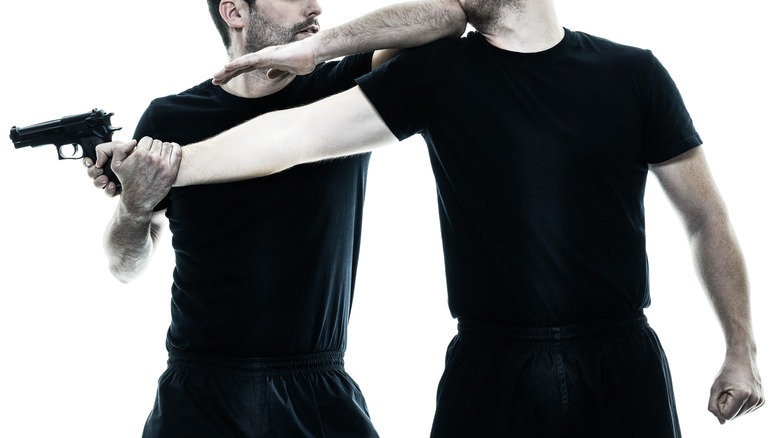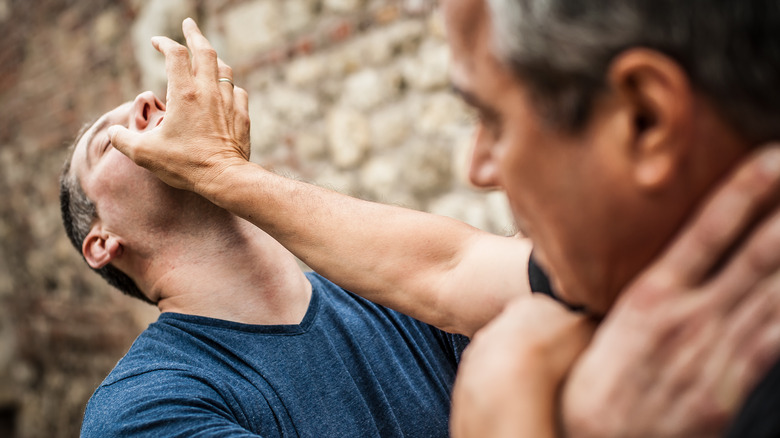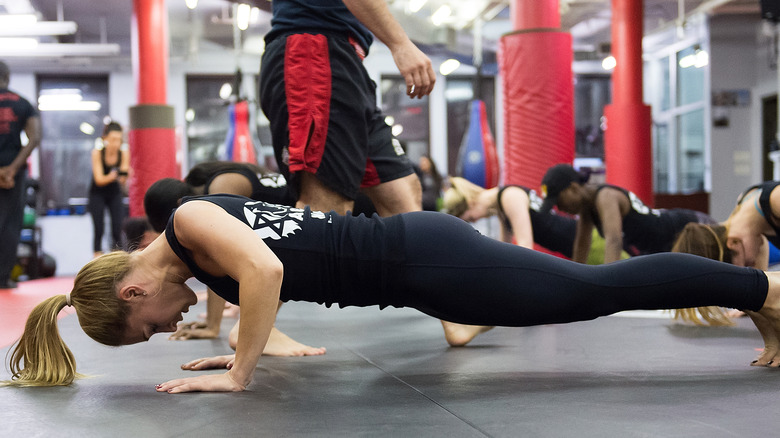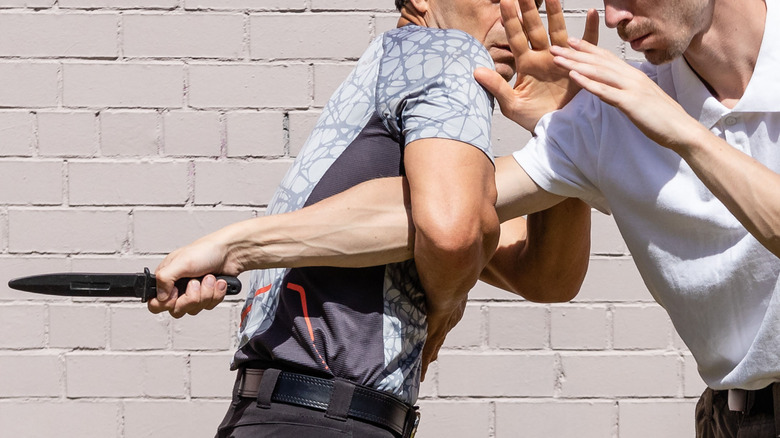The Origins And History Of Krav Maga Explained
A quick online search for something like "Krav Maga fight" reveals video after video of something that, on the surface, might look like simple, brutal street brawling: knives, guns, punching, kicking, protective gear, red and howling faces, lots of sweat, lots of black clothing, and more than a heaping serving of savagery. Or, Krav Maga might look like MMA, a mistake you'd be forgiven for making. As the Krav Maga Worldwide website succinctly states, "MMA is designed as a sport. While the move set is designed to incapacitate opponents, the goal is to do so without serious injury. Modern Krav Maga is intended to keep you alive in actual emergency situations by any means necessary."
And that's exactly the difference: Krav Maga isn't a martial art with a deep ancestral heritage like Shaolin Kung Fu, or the breakdance-meets-musical kick-a-thon of Brazilian Capoeira, or the wrestling-like grapples and pins of Judo. Krav Maga isn't a martial art at all. It's a parred-down, utilitarian self-defense system developed at the founding of the modern nation of Israel in 1948. It's used by current Israeli Defense Forces.
Practitioners are repeatedly told (paraphrased), "Your objective is to cause the maximum amount of pain in the shortest time possible, and then escape. Nothing is off limits."
Originally developed to protect Jews in Europe from fascist riots
Krav Maga has the honor of being the world's only fighting style designed to protect citizens on the streets against literal anti-Semitic fascists. In something that sounds like a mythologized origin story, Krav has roots in 1930s Bratislava, a city in what was once Czechoslovakia, now the capital of Slovakia in the country's southwest corner, about two hours from Budapest.
Leading up to World War II, Jews became targeted for violence across Europe. As Krav Maga Worldwide tells us, Imi Lichtenfeld, son of a prominent police detective in Bratislava, leveraged skills borrowed from boxing and wrestling to arm his local Jewish community against assaults and riots. He then emigrated to North Africa and joined the Free Czechoslovak Legion, a volunteer armed forces unit composed of Czechs and Slovaks working together with World War II's Allied Forces. Lichtenfeld wound up drawing the attention of the Israeli paramilitary group Haganah while there, and passed along his training to them, with a heavy emphasis on close-quarters combat and disarming opponents. After the war he was hired by the newly formed Israeli Defense Forces (IDF) to train soldiers.
Lichtenfeld became the Chief Instructor for Physical Fitness and Krav Maga (which translates as "contact combat," per Urban Fit and Fearless) at the IDF School of Combat Fitness. When he retired he took his knowledge to the private sector and founded the Krav Maga Association. Only as recently as 1983 did Krav arrive in the United States.
An utterly practical, non-flashy, brutal form of self-defense
Out of all fighting traditions and martial arts, Krav Maga tends to get a lot of respect for its approach to self-defense. In the world of armchair combatants who impugn various fighting techniques from behind the safe haven of a laptop screen, this is saying something.
As Krav Maga Worldwide states, "Assailants in the real world don't play fair. While certain moves and holds, such as groin strikes or fishhooking, are forbidden in MMA, Krav Maga has one rule: survive." Indoor and outdoor training, with or without weights, cardio and muscle, aerobics and gymnastics: Krav Maga both benefits from, and interacts with, all other forms of fitness. It's utterly practical, focused on finishing fights and not prolonging them. It is completely not flashy, and is designed for real-world scenarios. And because the Israeli Defense Forces' mandatory draft law has always included women, Krav is favored by all genders and applicable towards all body types and statures. Whether a petite young lady or a big burly dude viciously chops you on the bridge of the nose with an elbow, you're gonna shriek in pain and let go.
And in case you were wondering: yes, this means that Wonder Woman herself, Gal Gadot, a native-born Israeli, not only trained in Krav Maga while serving two years in the Israeli military, she served as a combat instructor, per the Krav Maga Defense Institute's Australian Youth Program.
Practiced the world over and taught to law enforcement personnel
At present, there are a multitude of Krav Maga associations across the world. While exact numbers are difficult to determine, one such large organization, Krav Maga Global, contains over 1,500 certified instructors in over 60 countries under the leadership of Israeli-born Eyal Yanilov, who began training in Krav Maga in 1974. In a fashion similar to martial arts, Krav Maga has developed a unified belt ranking system to track progress, outlined on Krag Maga Worldwide: levels 1 (no belt) through 5 (blue and brown belts). And because Krav Maga is essentially military training, certain centers offer certified courses and seminars for law enforcement personnel, with a full curriculum ranging from "De-escalation Tactics" to "Hostage Situations" and everything in between. Krav Maga Worldwide reports that the U.S.' Chief Instructor, Darren Levine, is a Deputy District Attorney for Los Angeles County.
There's lots of motivation for learning Krav Maga, including self-defense following a traumatic incident, general skeletal-muscular fitness, gaining a sense of progress in life by tackling and surmounting a difficult task, undertaking an inward, spiritual journey, and so on. Or as Hollywood tough guy Jason Statham plainly and gruffly states on Krav Maga Defense Institute's Australian Youth Program, "It gives me great skills, strength, and power." Of course, in all these ways Krav Maga is identical to the martial arts, other forms of strenuous exercise, and intense sports training.
They, however, weren't developed to punch Nazis.



